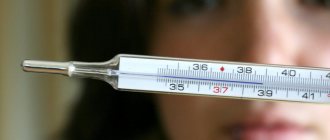One of the most important characteristics of our body and an indicator that we are healthy or something is still wrong with us is our body temperature. This indicator characterizes the physiological state and tells a lot about the human body. Since childhood, we have all been well explained that for a body that is not susceptible to any disease, the standard and normal temperature is 36.6 °C. A temperature above 37 °C indicates that there is some kind of disease, which, as usual, is accompanied by an inflammatory process.
Signs
Elevated body temperature in itself is a symptom, that is, a sign of a particular disease. As for the manifestations that usually accompany hyperthermia, the following can be distinguished:
- headache;
- feeling of aching in muscles and joints;
- hypersensitivity (tactile, photophobia, sometimes olfactory);
- general weakness;
- decreased appetite;
- irritated mucous membranes;
- chills;
- sweating;
- deterioration in concentration.
The severity of these symptoms largely depends on the severity of hyperthermia. Simply put, the higher the temperature, the more of the listed symptoms will accompany it and the more they will bother the patient. However, we should not forget about individual tolerance. Some patients already feel so bad at a temperature of 37.5 that they can hardly find the strength to get out of bed and make tea on their own. Others can easily tolerate much higher temperatures, with almost no loss of appetite or ability to work.
Symptoms
Symptoms of low/low temperature are determined by the indicators of its decrease. A decrease in body temperature within 36.0-34.0 degrees is most often accompanied by the following symptoms:
- general malaise, loss of strength, lethargy, weakness;
- cold pale/bluish skin;
- chills, trembling;
- lethargy, increased drowsiness;
- dizziness;
- weak rapid pulse;
- low blood pressure.
When the temperature drops below 34°C, a sharp drop in blood pressure , a weak, rare pulse (30-40 beats/min), shallow breathing, cold skin with a marbled tint, slurred speech, and increasing drowsiness may be observed.
Causes of high temperature
If the temperature rises, this is not always caused by the activity of pathogenic microorganisms. Hyperthermia may also have purely physiological causes: nervous tension, physical activity and overeating.
However, in most cases, an increase in temperature is still caused by the body's immune response. In infectious and inflammatory diseases, hyperthermia occurs as a defensive reaction - by increasing the temperature, the body tries to cope with bacteria and viruses.
Hyperthermia occurs due to the activity of pyrogens. These are protein compounds that indirectly affect the temperature regulation center in the hypothalamus, a part of the brain responsible for many vital functions of the body. Pyrogens are divided into two groups:
- Primary (exogenous). As a rule, these are exotoxins - harmful waste products of bacteria and other microorganisms. This also includes antigens of various origins.
- Secondary (endogenous). Under the influence of primary pyrogens, internal protein structures involved in immunological reactions are activated. These are secondary pyrogens, which in medicine are commonly called cytokines. It is they who activate a whole chain of reactions, as a result of which the hypothalamus receives a signal that it is time to increase body temperature and create conditions unsuitable for the comfortable existence of foreign microorganisms.
Under conditions of elevated body temperature, many bacteria stop functioning and multiplying. However, the protective effect of fever does not end there: cytokines also stimulate the synthesis and bactericidal activity of leukocytes - blood cells that are responsible for the body's immune defense.
The list of various diseases and pathological conditions in which hyperthermia is noted is quite extensive, so here we will list only the most common of them.
The most common causes of fever are the following:
- Respiratory and focal - colds, bronchitis, pneumonia, flu, pharyngitis, laryngitis, tonsillitis, sinusitis.
- Intestinal infections - dysentery, salmonellosis, yersiniosis, escherichiosis, rotaviruses, enteroviruses, cholera, botulism.
- Chronic infections: tuberculosis, syphilis, chronic tonsillitis.
- Complications during treatment - postoperative period, reaction to vaccination, complications of taking antibiotics and other drugs.
- Oncological diseases - fibromas, adenomas, lymphomas, leukemia, etc.
The causes of fever can also be autoimmune diseases, sepsis, injuries, helminthic infestations, allergic reactions and hormonal imbalances.
Figure 1. Main causes of elevated temperature. Source: MedPortal
Prevention
Preventive measures are determined by factors that cause a decrease in body temperature.
- To prevent the negative impact of environmental factors - adequate clothing in accordance with the weather.
- Elderly people - do not go outside for a long time in cold/inclement weather, maintain the temperature in the home at 20-22 degrees or wear warm clothes (woolen sweater, thermal underwear, warm socks, etc.), warm the bed at night, increase the amount of nourishing hot food and drinks, move more.
- Newborn children - prevention of a decrease in temperature is achieved by immediately drying the child and swaddling him, including his head in a warm blanket to prevent heat loss by evaporation, convection / conduction losses. Low birth weight and premature infants should be placed in an incubator or under a radiant heat source.
- For diseases that occur with low temperature (Addison's disease, anemia, hypothyroidism, hypotension, immunodeficiency states, intoxication of the body) - adequate and timely treatment.
- Children under one year old - normal body temperature in a child under one year old is maintained by maintaining the hanging temperature at 20-22 degrees, adequate clothing, proper nutrition, and hardening.
General measures include increasing physical activity, hardening the body, proper/balanced nutrition, enriched with vitamins/microelements, and drinking warm food/drinks.
Types of elevated body temperature
Classification of hyperthermia is carried out according to several criteria at once, but the most popular of them is the degree of severity based on measurement results. The following types are distinguished:
- Subfebrile (up to 38 C). There are 2 subtypes: low subfebrile condition (up to 37.5 C);
- high subfebrile condition (37.6-38.0 C).
- moderate (38.1 - 39.0 C);
Classification
It is generally accepted that the temperature in adults is within:
- 36.0-37.0 degrees is normal.
- 36.0 - 35.0 degrees - low body temperature (synonymous with subnormal). That is, any value within these limits (for example, 35.5; 35.6; 35.7; 35.8) indicates a low temperature.
- Below 35.0 degrees - hypothermia (mild - the temperature drops to 32.2-35.0 degrees; moderate - 28.0-32.1 degrees; severe - up to 26.9 degrees).
WHO classification (1997) of hypothermia in newborns:
- from 36.5ºС to 37.5ºС – normal body temperature;
- decrease in body temperature from 36.4 C to 36.0 C - mild hypothermia;
- decrease in body temperature from 35.9ºС to 34.0С - moderate hypothermia;
- body temperature below 32.0 C - severe hypothermia.
Diagnostics - how to measure temperature correctly
There are several ways to measure temperature, each of them having its own advantages and disadvantages. Let's look at them in more detail.
Axillary
This is a well-known method that involves measuring the temperature in the armpit. The undeniable advantage is simplicity and convenience, but the disadvantages include errors (0.1-0.3 C) in comparison with more accurate methods. In addition, the temperature in different armpits may vary slightly.
Rectal
The temperature is measured in the anus. It is most often used in children under 4 years of age, who are difficult to persuade to calmly hold the thermometer under their arm for several minutes. Formally, this method of measuring temperature is considered the most accurate.
However, there are a number of caveats here too. Firstly, it is important to make allowance for the fact that the temperature in the rectum is always slightly higher than in the armpit - the upper limit of normal is 37.7 C.
Secondly, rectal temperature may vary depending on the fullness of the rectum with feces. By the way, for most people this method causes both aesthetic and physiological discomfort. If there are convinced supporters of rectal temperature measurement in the family, it is advisable for them to have their own thermometer, which should be disinfected after each use.
Buccal
The temperature is taken in the mouth, preferably under the tongue. The advantage is that the indicators are more accurate compared to the axillary method. Disadvantage: the temperature is affected by the food and liquid consumed the day before the measurement. It is also important not to open your mouth during measurement - this also affects the accuracy of the result.
other methods
There are several less common ways to measure temperature:
- Liquid crystal thermography. It is based on the capture of thermal radiation using liquid crystals (contact method) and a mirror scanning system (remote method). As a result, a multi-colored image is displayed on the screen, which is called thermoscopy - something like how hostile aliens see people in science fiction films.
- Thermometry in the area of the temporal artery. A new method, which is considered the most accurate, but has not yet become widespread, since infrared thermometers have not yet become firmly established in our everyday life.
- Tympanic method. It is almost never used in Russian clinical practice; this method is more popular in Germany. Temperature measurement is carried out in the area of the external auditory canal.
- Vaginal. Usually used by women who are unable to get pregnant - the most favorable period for conception (ovulation) is determined by temperature fluctuations.
Febrile fever! What to do about it?
Fatigue, drowsiness, hot flashes or cold chills, sweating, trembling and facial flushing. The listed symptoms are frequent companions at elevated temperatures. Moreover, depending on the cause leading to this symptom, there are other manifestations. However, adequate and effective treatment for febrile fever is prescribed after the etiology of the condition has been established. Since febrile temperature itself may be a sign of another disease.
Elevated temperature is divided into subfebrile (from 37 to 38 degrees), febrile (from 38 to 39 degrees), high or pyretic (from 39 to 40.9 degrees) and excessive or hyperpyretic (over 41 degrees).
Establishment of elevated body temperature occurs after correct measurement using suitable means for this purpose. Many parents can register even minimal deviations from normal body temperature. When they touch their children's foreheads with their lips. But it is usually recommended to measure this using appropriate thermometers.
Correct measurement of body temperature
Body temperature is measured using mercury or digital thermometers. Moreover, the use of the former is prohibited in many countries. Reason: risk of mercury poisoning if the thermometer is accidentally damaged.
When taking measurements, the thermometer is often placed in the armpits (axillary). In the mouth (orally), rectally, in the ear (in infants), and also on the skin itself.
However, the most accurate results are obtained by measuring rectal temperature. Because with this method the influence of external factors is the least pronounced. But, it should be borne in mind that rectal temperature is 0.6 ° higher than that measured orally.
The golden mean in terms of accurate results and comfort during measurement is placing the thermometer under the arm. In this case, you need to be motionless for several minutes so as not to move the thermometer.
Body temperature shows circadian rhythm. Therefore, measuring in the early (morning) and late (afternoon) hours will show different results. Therefore, it is normal for our temperature to be lower in the morning. And at dusk, the thermometer can show higher values (deviation from 0.1 to 0.3 units).
Temperatures up to 37.4° are not considered high. Because it is believed that up to these values, the body itself can fight the cause and produce antibodies.
Of course, to effectively combat unpleasant symptoms, it is necessary to identify in advance the specific causes that led to the increase in temperature. However, unauthorized use of antipyretics can lead to temporary normalization of body temperature. But with resistance to the main problem (or disease), it may increase again. And also a number of other manifestations may be added to it.
Febrile temperature: causes
Febrile fever is generally due to two large groups of causes, namely infectious and non-infectious.
Infectious causes of febrile fever include all known microbial agents (pathogens). Which, when entering the body, can cause various manifestations, often in combination with elevated temperature.
Due to the variety of microorganisms that can settle in our body completely uninvited, infections are the most common cause of febrility.
In many cases, febrile fever is the main symptom and can be involved in diseases such as Q fever, yellow fever, spotted fever, viral fever and many others. In other infections, febrile temperature is one of the main alarming symptoms. Moreover, the time period of the day is also of great importance (for example, with tuberculosis, night sweats as a result of febrility are especially characteristic).
The most common infectious causes of febrile body temperature include:
viral infection
The most common viral pathogens of fever are the influenza virus and various respiratory viruses that cause colds. Associated symptoms often include cough, sore throat, nasal discharge (or stuffy nose), pain throughout the body;
bacterial infections
Associated symptoms directly depend on the location of the process. For example, when the central nervous system is infected, in addition to elevated temperature, there is a constant headache, stiff neck, confusion, and mental changes. Whereas when the digestive system is infected, additional symptoms often include abdominal pain, nausea and vomiting, diarrhea, and blood in the stool. Respiratory bacterial infections occur with fever, wet cough, difficulty breathing and much more. In addition, a common cause of febrility is hidden, often insidious infections in the urinary tract with bacterial etiology (in most cases);
fungal infection
Fungal diseases (mycoses) are a rare cause of fever. In such cases, manifestations are usually observed on the skin and skin appendages (with superficial mycoses) or internal organs (with systemic mycoses). Particular attention should be paid to patients with chronic immunodeficiency, since their febrile state may be associated with an opportunistic infection, which very often occurs as a result of mycosis;
protozoal infection
Although malaria is not a disease specific to our latitudes, it is considered one of the most common protozoal diseases. They lead to an increase in body temperature in combination with other characteristic manifestations. And they require timely treatment to reduce the risks of developing various types of complications;
sexually transmitted diseases
Maintaining a low-grade or elevated temperature for a long time, without the presence of other manifestations and without a significant effect from antipyretics, requires the exclusion of a sexually transmitted disease (gonorrhea, syphilis, chlamydia, HIV and others) as the cause.
Infectious diseases can be possible causes of increased body temperature. But very often the cause of a febrile condition lies not in the penetration of uninvited microbes and infectious agents, but in completely different reasons.
Non-infectious causes most often include:
autoimmune diseases
For example, with lupus, rheumatoid arthritis, periarteritis nodosa, sarcoidosis. With them, our own immune system perceives us as enemies and attacks various cells. With these ailments, febrile temperature is often observed:
hormonal disorders
With hypothyroidism (thyroid disease), there is an increase in metabolic processes in general. As well as increased energy burning and febrile temperature;
tumor
For example, the presence of a primary or secondary (metastatic) tumor in the brain can damage the hypothalamus. It is a kind of “thermostat” that regulates our body temperature. In addition, an additional factor is severe immunodeficiency. It occurs as a result of neoplasia (new growth), which predisposes to various infections. And also to anti-cancer treatment (many anti-cancer drugs can lead to fever as a side effect);
medicines
A number of medications lead to side effects and unwanted effects such as febrile fever. Examples are beta-lactams (penicillins, cephalosporins, carbapenems, monobactams, which are a group of antibiotics). Isoniazid (a drug used to treat tuberculosis). Alpha-methyldopa (used to treat high blood pressure). Procainamide and quinidine (medicines used for arrhythmias). Immunosuppressants and antineoplastic drugs (used in oncology). In addition, febrile temperature, in addition to side effects, may be one of the first signs of an allergic reaction to the drug used. It should be considered and treated with caution if fever occurs soon after starting treatment with a new drug;
immunization
Administration of vaccines (mandatory immunizations or vaccines that are given at the request of the patient) may lead to a temporary slight increase in body temperature. Parents are usually warned about this possible (and relatively common) side effect when administering mandatory childhood vaccines, with some using antipyretics (usually paracetamol) for prevention, and others advising parents to closely monitor the child's temperature every two to three hours, and if it rises the child’s temperature is given an appropriate dose of an antipyretic;
environmental factors
Excessive physical activity, especially in hot weather, as well as resulting from dehydration, can cause increased body temperature and even the development of heat stroke;
alcohol and drugs
Abuse of alcohol, cocaine and amphetamines can lead to fever. Febrile fever may also occur during withdrawal symptoms. When you stop taking illegal substances and/or alcohol.
After identifying the specific root cause leading to the development of a febrile condition, targeted measures are taken:
- firstly, for timely normalization of temperature;
- secondly, to treat the disease process (or eliminate the underlying causes).
Medicines for the treatment of febrile fever
Many people are afraid of diseases, doctors and hospitals. As soon as they see 37.0°, they immediately reach for first aid kits. Well, at 37.2° they experience great excitement. And only fear “saves” them from visiting the emergency room.
In the absence of additional symptoms (shortness of breath, vomiting, diarrhea, severe pain, lethargy, changes in mental status, rash) and a temperature above 38.4 °, it is recommended to increase fluid intake and rest. At the same time, temperature is a signal that our body has taken matters into its own hands and is actively fighting pathogens. Therefore, in such a situation, the best strategy is to monitor temperature values over several hours.
If this temperature is exceeded and there are no significant additional symptoms, you can turn to widely advertised and well-known antipyretic drugs:
paracetamol
It has a well-known antipyretic effect and good analgesic properties. This is a safe remedy that can be given to children aged three months and older. And also for women during pregnancy and breastfeeding. This is one of the most commonly used remedies to reduce body temperature. Often included in combination products for the treatment of colds and flu, migraines, headaches, and fever. But, there is a risk when using high doses (development of allergies, liver damage, kidney complications and others);
ibuprofen
In addition to exceptionally good antipyretic properties, ibuprofen also has good anti-inflammatory activity and analgesic effect. This makes it an excellent remedy for febrile fever. Especially occurring with severe pain as a result of the underlying inflammatory process. Ibuprofen is safe to use during pregnancy. After consultation with a doctor, it is usually used in the first months of pregnancy. Since it may hide risks when used in the last trimester. It is safe during breastfeeding. The drug of choice for the development of one of the most common causes of febrility in nursing mothers, namely mastitis. But, due to the well-known risks associated with long-term use of non-steroidal anti-inflammatory drugs, it is not recommended to use them in the presence of gastrointestinal bleeding, peptic ulcers, severe renal, liver or heart failure, hematopoietic disorders and others;
acetylsalicylic acid
Acetylsalicylic acid is a widely used antipyretic agent found in combination products. An important feature is that depending on the doses used, it can exhibit different effects. For example, antipyretics and painkillers (with a standard dose of 500 mg). Anti-inflammatory (at high doses above two grams). Antithrombotic (at low doses up to 150 mg). Not recommended for hemorrhagic diathesis, peptic ulcers, allergies, as well as in the last three months of pregnancy;
metamizole sodium
A widely used remedy that affects not only elevated temperature, but also the accompanying pain syndrome of various origins (toothache, headache, neuralgia, biliary and renal colic, and others). Long-term use (for example, for symptomatic effects of fever or pain of unknown origin) is not recommended. Due to the risk of damage to the urinary system and the development of so-called analgesic nephropathy.
You should always follow the recommended dosages. They are usually listed on product leaflets or prescribed by a doctor.
Different preparations contain different doses of the respective active ingredient. In an effort to quickly relieve suffering, a person may take more than necessary.
For example, the maximum daily dose for paracetamol and aspirin is 4 grams. Which is 8 tablets of 500 grams (the most common dosage) or 4 tablets of 1 gram (1000 milligrams). The real risk is with flu and cold powders (most of them contain paracetamol) and pure paracetamol alone. The main manifestations of an overdose include nausea, vomiting, loss of appetite, abdominal pain, sweating, and drowsiness.
Taking high doses of aspirin carries a risk of exacerbating peptic ulcers. As well as bleeding, exacerbations with concomitant gastrointestinal diseases. At the same time, aspirin is contraindicated for children under 16 years of age (leads to Reye's syndrome, which occurs with severe neurological and hepatic disorders).
Metamizole sodium can be taken by adults and children over 15 years of age at a dose of up to 3 g (6 tablets of 500 mg) per day. For children aged 10 to 15 years, the maximum daily dose is 2 grams. And its use is not recommended for young children. This drug may cause side effects that vary in severity. Allergic reactions, abdominal pain, nausea, changes in appetite. And its use with other drugs (especially antidepressants, anticoagulants, analgesics, antihypertensive drugs) can lead to serious unwanted drug interactions.
If your condition remains unchanged for more than two to three days and the temperature does not decrease even after taking medications, as well as in the presence of alarming symptoms (vomiting, diarrhea, swelling, rash, blood in the urine, feces, sputum), then you should definitely consult a doctor. He must conduct the necessary research to establish the cause that led to the increase in temperature. And then prescribe the medications most suitable for your condition.
Symptomatic medications (paracetamol, aspirin, ibuprofen) do not cure, but only alleviate symptoms.
Often, antipyretics also include appropriate etiological agents for the treatment of the underlying disease. They are prescribed specifically for a specific pathogen:
- antibiotics: infectious diseases with proven bacterial etiology are treated with antibiotics. After conducting an antibiogram and determining the drug to which the relevant bacteria are sensitive;
- antiviral drugs: viral infections are well affected by antiviral drugs (anti-influenza, anti-herpetic, anti-retroviral and others);
- antimycotics: the presence of a fungal infection requires the use of suitable antimycotic drugs for systemic use;
- chemotherapy: neoplasia (depending on their type, location, characteristics) is well influenced by the use of chemotherapy in a specific drug regimen and dosage regimen;
- immunosuppressive drugs: in the presence of an autoimmune disease. Long-term (even lifelong) therapy with suitable immunosuppressive agents is often required.
Thanks to treatment and elimination of the cause that led to the febrile condition, the body temperature gradually normalizes.
If there are side effects from drug treatment, you need to talk to your doctor about a possible drug change.
Alternative remedies for fever are some of the proven folk methods. These include: cold compresses, wrapping in damp sheets, applying ice to the forehead, compresses with vinegar. A fan next to the bed, antipyretic patches containing menthol and others. These methods can help if a person has a common cold. But they will not be particularly effective or sufficient if there is a more serious infection or underlying disease.
Medicines and treatments for febrile fever in children
In childhood, the risk of febrile illness even with a slight increase in temperature is much higher. Since in children these temperature values can rise quickly. They often become dehydrated and are at risk of developing febrile seizures. For this reason, prompt and timely action is recommended. Aimed at lowering the temperature and establishing the causes of febrility.
If there is a fever in infants under three months, a visit to the attending physician and consultation to determine the causes are required. Even despite the absence of other manifestations and the child’s satisfactory general condition.
Mild fever (without other symptoms) in children aged three to six months can be managed with plenty of fluids and rest. In the event of an increase in temperature, maintaining a temperature for a longer time, or the presence of other manifestations, timely consultation with a specialist is necessary.
Mild fevers in children aged 6 to 24 months can be easily and quickly managed with appropriate antipyretics. And if you have any alarming symptoms, you should consult a specialist.
Low-grade fevers in children and adolescents aged 2 to 17 years can be treated with alternative remedies. And if they have a fever, they can be given antipyretics, which are allowed in childhood.
The most commonly used medications and treatments for fever in childhood include:
paracetamol
Paracetamol is the drug of choice for infants over one month of age. Young children and teenagers. There is usually no risk of serious side effects when recommended dosages are followed. For infants and young children, it is recommended to give this medication as a syrup or oral suspension. As well as rectal suppositories (suppositories). Older children can take this drug in tablet form. The dose is usually based on the child's body weight;
ibuprofen
Ibuprofen is available in the form of rectal suppositories (suppositories), syrup, oral suspension, tablets and capsules. It is approved for children over 6 months, young children and teenagers. In the presence of febrility with accompanying manifestations (pain, inflammation, etc.), preference is still given to paracetamol. Because of its excellent anti-inflammatory and analgesic properties. Ibuprofen rarely causes side effects. However, it is not recommended for adolescents and young children with gastrointestinal disorders.
Permitted symptomatic drugs for children under 16 years of age (in some countries up to 19 years of age) are paracetamol and ibuprofen. Aspirin is absolutely contraindicated due to the risk of developing Reye's syndrome, characterized by severe neurological and hepatic symptoms. It is not recommended to give infants and young children so-called powders, which contain (except paracetamol) various additional ingredients;
fluid intake
Infants and young children become dehydrated very quickly, with the risk of developing associated complications. Therefore, in the presence of fever, especially in combination with vomiting and/or diarrhea, it is recommended to ensure adequate fluid intake (breast milk or adapted milk for infants, water, tea). At elevated temperatures, there is usually a lack of appetite. Therefore, it is not recommended to force your child to eat. But it is necessary to ensure that you consume enough fluid;
bed rest
Febrile fever often causes weakness, fatigue and drowsiness. Therefore, bed rest is recommended to more quickly restore the body’s strength and improve the child’s condition;
cold compress
A cold compress (a towel or diaper soaked in cold water and placed on the forehead, in the axillary area, on the legs) can be used as an additional remedy or as an effect on slightly elevated body temperature;
limiting social contacts
Since febrility can be caused by infection (in babies this is one of the most common causes), isolation is recommended, since there is a risk of secondary infection and the development of a bacterial infection or deterioration of the child’s condition;
other measures
Bathing in slightly warm water (never cold or hot), maintaining a lower temperature in the room, wearing as little clothing as possible, massaging the feet and a number of other measures can be taken as part of the comprehensive treatment of a febrile condition;
alternative means
Compresses with apple cider vinegar, the use of herbs, medicinal plants and traditional medicine recipes can be used as additional treatment, but only after consultation with a specialist.
Adequate and timely measures to control temperature in childhood are extremely important, since febrile illness in children carries numerous risks and can lead to serious complications. Untreated and untreated, underlying infections may result in hospitalization and more aggressive treatment, and they may become so chronic that a specific therapeutic treatment plan is required.
Identifying the causes of febrile illness underlies effective treatment of febrile fever and rapid symptom control in individual patients (regardless of their age).
Express Your Reaction
Which thermometer is better to use?
So far, the most common type of thermometer remains the mercury thermometer. It gives more accurate results than electronic ones and does not require changing batteries. However, from a security point of view, it is, to put it mildly, not ideal. Mercury is very toxic, so if there is a small child or an elderly person in the house, who most often break thermometers, it is better to accept minimal deviations from the exact result and purchase an electronic analogue. By the way, another disadvantage of a mercury thermometer is that the measurement takes too long - on average about 10 minutes. An electronic thermometer copes with its task 3-4 times faster.
Infrared thermometers are an excellent combination of measurement accuracy and safety of use. Their only drawback is their high cost, so many people prefer to use cheaper options.
Galinstan thermometers have also appeared relatively recently - they are more affordable, and they are exactly as good as mercury thermometers. Galinstan is a mixture of low-toxic liquid metals, so from a safety point of view, everything is in order here too.
What devices measure temperature indicators?
There is a wide variety of instruments in the world for measuring human body temperature. Thermometers still remain one of the most popular products, so global manufacturers offer a variety of models. The most famous type of thermometers in Russia are mercury thermometers. This thermometer is characterized by high accuracy, availability and is still in great demand. However, there are not as many such thermometers in the world as before, because they are quite fragile and pose a danger. The mercury they contain is poisonous. Its high degree of deodorization is dangerous and can cause harm to humans and animals.
Electronic thermometers have become more popular in the world. Their most interesting feature was the ability to measure indicators in just 30 seconds. As soon as the measurements are completed, the device will notify you with a sound signal. Alas, such devices do not provide accurate values. Therefore, manufacturers of such thermometers indicate the error in the instructions. Nevertheless, they are the ones who have gained the greatest popularity all over the world.
The most modern type of thermometers in the world are infrared. With their help, you can measure the indicator contactlessly, getting results in just 5 seconds. The error of this type of thermometer is very low and is no more than 0.5°C. A characteristic feature of the infrared thermometer is its limited use. It can only read data from a certain area, for example, the temple, forehead or ear. Moreover, the coverage is purely single, so if the device is designed to measure across the forehead, then it will be impossible to measure in another zone.
Nowadays thermal strips are becoming widespread around the world. They are widely used due to their ease of use. This strip can be applied to the forehead and in a minute it will show the result. The definition occurs along the boundaries, which helps to find out the most necessary information. Because of this, thermal strips cannot replace a full-fledged thermometer.
What diseases cause high fever?
We talked about diseases that cause an increase in body temperature above. The table below lists the main groups of these pathologies with the average temperature range.
| Group of diseases | Minimum | Maximum |
| Respiratory | 37,0 | 40,5 |
| Intestinal infections | 37,5 | 41,5 |
| Oncology | 37,0 | 38,0 |
| Chronic infections | 37,0 | 37,7 |
| Worm infestations | 37,0 | 37,5 |
| Autoimmune systemic diseases | 37,0 | 38,0 |
| Sepsis | 37,0 | 42,5 |
The table shows only values associated with hyperthermia. However, in a number of observations (including in cases of sepsis), there are exceptions when the temperature may not increase, but decrease.
What are the different forms of fever?
The familiar pink (red) fever is not always a dangerous signal. She announces herself by redness of the skin, a characteristic blush on the cheeks. With red fever, the body is able to function quite normally and provide proper heat transfer.
The most serious danger is caused by white fever, which is recorded relatively rarely. It may be caused by vasospasm. With white fever, processes associated with thermoregulation fail. The skin becomes white, the hands become cold, and the thermometer shows a high temperature level. White fever is very dangerous because the heat can damage internal organs.
Why does high fever last for a long time?
In most observations, the temperature rises in response to the activity of foreign microorganisms. A prolonged increase in temperature can be understood as hyperthermia, lasting several days during acute colds or infectious diseases, or chronic low-grade fever.
In the first case, the cause usually lies either in the severe course of the disease or in improper treatment, when an incorrect diagnosis does not allow the cause of the fever to be eliminated. If the patient tolerates an elevated temperature normally, it is better not to bring it down - this will help the body cope with the infection faster.
As for chronic low-grade fever, when a temperature of 37-38 C lasts for several weeks or longer, this condition is usually caused by the transition of an infectious disease from the acute to the chronic phase. This often happens as a result of improper treatment. For example, often a patient, not wanting to consult a doctor, follows the advice of friends who recommend “proven” antibacterial or sulfaniladmide drugs. However, often these drugs may simply not be suitable for the patient’s indications. As a result, the disease goes into remission for a short time in order to soon take a chronic course.
Important! If the temperature reaches febrile values (38 C or higher) and lasts more than 4 days, you should consult an infectious disease doctor.
Another common mistake in the treatment of infectious diseases is to stop taking antibiotics at the first signs of improvement, without completing the course. This also contributes to the chronicity of the disease, and can increase antibiotic resistance of bacteria.
The possibility of developing diseases of the endocrine system and autoimmune pathologies should also be taken into account. And sometimes a prolonged increase in temperature can be caused by head injuries, as a result of which the hypothalamus suffers.
Prolonged hyperthermia in the range of 37-38 C is often observed in the case of herpes viruses, which can masquerade as other diseases (from respiratory to diseases of the central nervous system). The most famous representative of this group of diseases is the Epstein-Barr virus.
Chronic diseases of the liver, kidneys and gastrointestinal tract during exacerbations can also cause an increase in temperature. In this case, they will be accompanied by symptoms characteristic of the disease that caused hyperthermia. For example, an increase in temperature during exacerbation of colitis will be accompanied by painful sensations in the abdomen, a feeling of incomplete bowel movement, nausea and flatulence.
What not to do at high temperatures
There are quite a few restrictions, and they often affect stereotypes that have been established in home treatment over many years. Here are the main errors:
- You should not get carried away with excessively fatty and spicy foods - they increase the load on the digestive system, and this prevents the body from fighting infection. Preference should be given to easily digestible dishes. However, the food should not be too hot.
- It is important to avoid breastfeeding, as at elevated temperatures the proteins contained in milk thicken, which affects taste and digestibility.
- It is undesirable to drink sweet tea or coffee - high levels of glucose in the body suppress the activity of leukocytes, which ensure the functioning of the immune system. In addition, coffee increases dehydration, which can worsen the course of the disease.
- You cannot steam your feet or do hot inhalations or take baths. Such methods only stimulate blood circulation. And this will entail an even greater increase in temperature.
- Another popular type of home-grown torture is warm wrapping. Many parents to this day continue to wrap their children in several blankets when they have a fever, after implementing points 3 and 4. There is an opinion that “sweating” during a fever is useful. In fact, the temperature rises even more, increasing the load on the cardiovascular system.
- It is also better to refrain from cold compresses - they really help reduce the temperature, but sudden cooling itself can lead to an even greater weakening of the immune system.
- Alcohol should be avoided. At elevated temperatures, the patient takes medications that increase the load on the liver. Alcohol, contrary to popular stereotype, does not destroy microbes, but has a hepatotoxic effect - it can only aggravate the course of the disease.
Diet
There is no special diet for low temperatures. However, an increase in heat production in the body is facilitated by a properly formulated diet, which should include the use of spices (cloves, cinnamon, cayenne pepper), fresh juices, full-fat chicken broth, red meat, ginger root, dark chocolate, coffee, brown rice . Drinking plenty of warm drinks (green tea with honey, herbal infusions) will also help restore low body temperature. At the same time, if low body temperature is caused by various types of diseases, special diets may be prescribed:
- Diet for low blood pressure.
- Diet for anemia.
- Diet for hormonal imbalance in women.
- Diet for hypothyroidism of the thyroid gland.
- Diet to boost immunity.
High temperature in an adult
As in children over 3 years old, adults are considered to have a high temperature of 37 C and above. Some people may feel discomfort even when the temperature approaches the low-grade mark (that is, from about 36.8 C), however, this is not yet a reason for worry - it is quite possible that such a condition was the result of overwork or nervous tension.
In adults, it is recommended to lower the temperature only when the reading is 38.5 C, however, as in the case of children, much depends on individual tolerance and the state of the body - special caution should be taken in patients prone to convulsive syndrome. When the thermometer approaches 39 C, the temperature must be brought down, since in this case the protective reaction itself becomes dangerous for the body - blood clotting increases, it thickens, and it becomes difficult for the heart to redistribute it to organs and tissues.
Medicines for high fever
When prescribing drugs to eliminate high fever, the doctor must show flexibility in therapeutic tactics, focusing primarily on eliminating the cause of the fever, the general condition of the patient and his tolerance to drugs. To reduce the temperature use:
- ibuprofen;
- paracetamol;
- acetylsalicylic acid.
Based on these drugs, many medications are produced with various commercial names.
Important! For children under 12 years of age, acetylsalicylic acid and metamizole sodium are contraindicated due to toxicity and negative effects on hematopoiesis.
To reduce the temperature non-medically at home, you can use wiping with gauze or other cloth soaked in cool water. Vinegar or alcohol should not be used for these purposes - they have no advantages over ordinary water, but their evaporation increases the general intoxication of the body.
When to call an ambulance
A sharp rise in temperature above 38.5 C, a feeling of pain in the mucous membranes, shortness of breath, and photophobia may be a cause for concern. An ambulance should also be called if infectious diseases are suspected:
- depression of consciousness or convulsions at the peak of temperature rise
- prolonged fever;
- rash;
- vomit;
- diarrhea;
- impurities of blood and mucus in the stool.
If at least one of the listed symptoms is observed in both an adult and a child, you should immediately call an ambulance.
Figure 2. Memo - when to call an ambulance if you have a fever. Source: MedPortal











